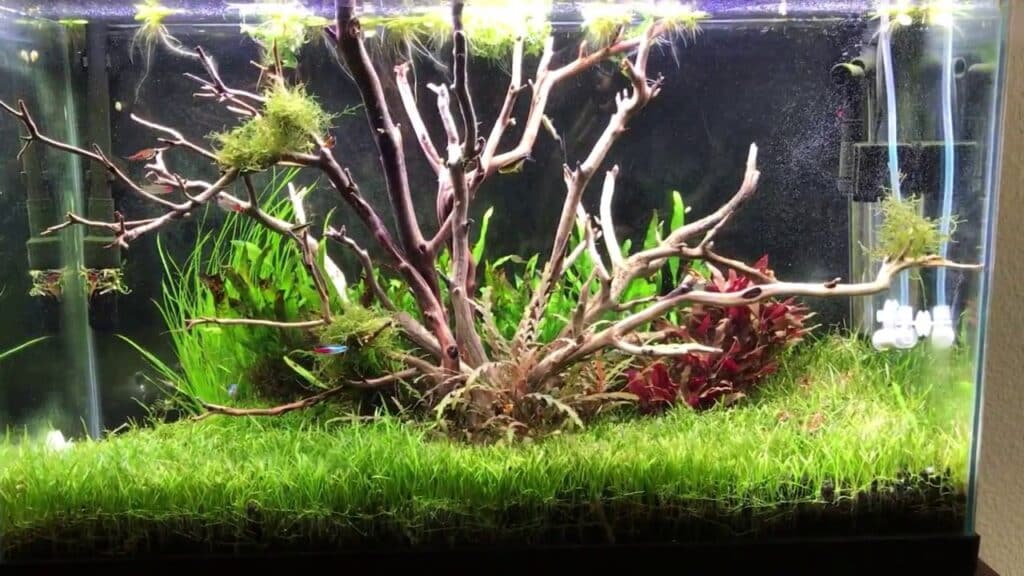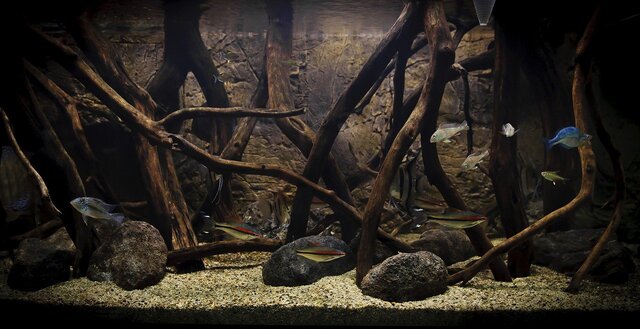A lot of people wonder about the best driftwood to put in their aquarium, and for us, the answer is Manzanita wood. Building a thriving aquarium ecosystem is more than just the fish, shrimp, and snail. It is also about creating a beautiful aquascape that is interesting to look at and a lively environment so the inhabitants can feel at home.
Manzanita itself is the common name for the Arctostaphylos genus, which comprises several different species. But today, we will be talking about the specific wood that you can use in your aquarium. Let’s go!
Table of Contents
Where is it from?
Manzanita is an evergreen shrub often found in the mountain regions of the western USA including Utah and Arizona, and even New Mexico and Texas. These areas, or chaparral biome, consist of shrublands with a colder climate.
These tough and hardy plants can survive harsh conditions and are great for fire logs. With more than 105 species, Manzanitas are well-known for their smooth bark and exotic, twisting branches.
Is Manzanita Driftwood Safe for Aquariums?
To address the most important question regarding this wood species, the answer is yes. Many hobbyists love using Manzanita because it is non-toxic and extremely safe for your fish. In addition, it is also not oil and contains no resin.
While this wood has some tannins, the level is very low that it will not harm your fish in any way. But it might cause the water to be murky. Still, we recommend soaking and preparing it correctly before placing the wood in your aquarium. This will help remove any tannin content.

Otherwise, your Manzanita may turn the aquarium water into an unattractive brown color. Surely that is not something any aquarist wants! Not only does it make your fish’s home dirty, but it also does not look all that pleasing either.
Another great thing about Manzanita wood is that it preserves really well and can last for decades in a tank. Plus, it will not decay and contaminate the water, unlike some other wood species.
Preparing Manzanita Driftwood for Your Aquarium
So, we’ve established by now that Manzanita wood is a fan favorite when it comes to choosing driftwoods in a tank. It is beautiful, long-lasting, and completely safe for your fish friends. And yet, using it is not as easy as plopping a chunk of the wood into your aquarium. There are several things you need to do to prepare it!
As we have mentioned earlier, the most crucial point is to leach out tannins in the wood. If your Manzanita still has bark, don’t forget to peel it first. As with any driftwood, we do not recommend adding them with the bark into your tank as it will affect the fish’s health.
The next step is to sterilize the wood. Start by brushing off any dirt and sand that are still clinging on. If the wood piece is exceptionally dirty, you can wash it in water or even boil it to kill any bacteria.
Once you have a clean wood, continue by soaking it for at least a week. This will not only remove the tannins but also saturate the wood enough that it will sink in the tank. The exact time can actually vary from 24 hours to two weeks, depending on the size of your wood and if you have boiled it (which will speed up the saturation process).
In general, you will know that your Manzanita is ready when it sinks to the bottom of the water. If you have done this for weeks and the wood still floats, you can weigh it with some rocks, tiles, or bury it into the substrate.
If you are impatient and want to add the wood directly into your tank, we recommend at least washing it off. The tannins should not affect the fish, though they will change the color of the water.
More About Manzanita Wood
Also known as Mountain driftwood or Manzanita driftwood, this species is often used in terrariums and reptile tanks in addition to aquariums. You can buy it sandblasted, which can bring out a variety of beautiful colors, from a gorgeous white and creamy brown to red. Or you can even get aged Manzanita when the bark will have already naturally peeled.
As it is a softwood, it is already denser and hardier than a lot of other wood types. When alive as small trees, Manzanita can survive in poor soils and does not need too much water. The trees themselves produce flowers and berries. This also means the wood decays much slowly.
Some of the shrubs can grow as high up as 20 feet, while the harvested branches vary between 18 and 36” in length. You can choose the most suitable size that can fit in your aquarium. The long and narrow stalks can add a unique, dynamic look to the aquascape environment.
Moreover, Manzanita is especially popular for aquariums because the color can pop when the wood is wet and submerged. The result is bright and attractive driftwood that can elevate the appearance of your tank.
The wood may also become covered in algae if you don’t clean it regularly. To further control the algae growth, we recommend introducing a peaceful algae-eating species.
Where Can I Find Manzanita Wood?
Perhaps you are now convinced that you should be using Manzanita wood in your aquarium, but where can you get it? Considering they originate in the western part of the United States, most local or online stores will supply the wood from there.
Try to buy the best quality wood that is pest-free. We recommend buying from a specialized pet or aquarium store instead of a commercial hardware store. This is to ensure that they have not treated the Manzanita with harmful chemicals and pesticides.
To wrap things up, Manzanita wood can be the perfect driftwood to grace your tank. Whether you are new or seasoned in your fishkeeping journey, it is never a bad idea to add this gorgeous wood into your aquascape. Good luck!






